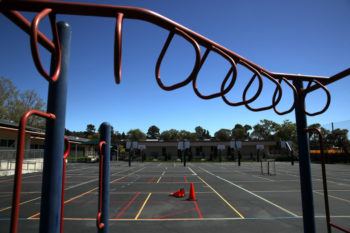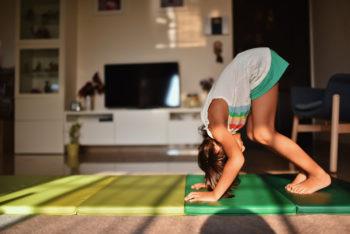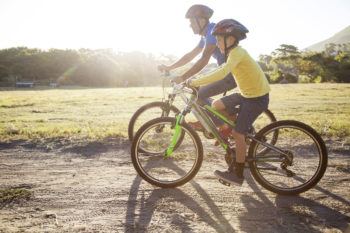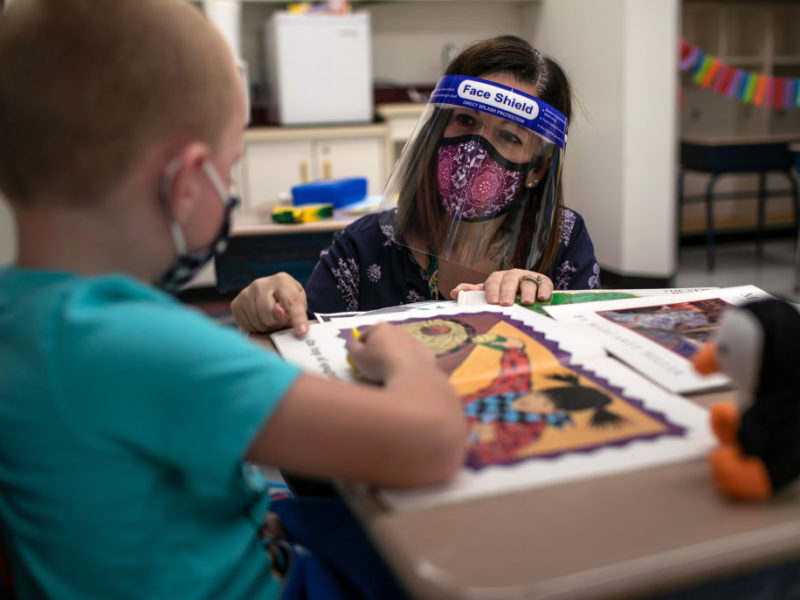Integrating Physical Activity Into Distance Education

In the wake of the COVID-19 pandemic, online lessons and homeschooling are the new normal in education. How does physical activity fit into this new mode of learning?
The Texas A&M University College of Education & Human Development spoke with Hildi Nicksic, clinical assistant professor in the Department of Health and Kinesiology, about why physical activity is important for students during this time.
Q: How does physical activity facilitate learning?
A: Most of us are familiar with the physical benefits of activity and exercise, but it is important to remember that being physically active also helps with brain health and cognition. Higher fitness levels, the result of ongoing engagement in physical activity, are associated with higher grades and test scores compared to those with lower fitness levels. On a more immediate basis, physical activity also increases concentration and attention, which directly impacts learning preparedness. Similarly, individuals tend to respond faster and more accurately to questions directly after being physically active. This is particularly true when more complex thinking is required, as physical activity seems to help the brain work more efficiently and effectively.

Q: How has the pandemic affected physical education?
A: School-based physical activity opportunities are a critical method of engagement to help children achieve the recommended 60 minutes of physical activity each day. With our nation at a standstill and our population quarantined, students are staying home instead of attending school. This means they are not experiencing physical education class or structured recess.
While implementation and enforcement constitute a separate issue, 74% of states require at least some participation in physical education for K-12 students. Quality physical education programs are essential in teaching children skills that will enable them to adopt physically active lifestyles. Fostering physical literacy – the motivation, ability, and confidence to engage in a range of physical activities across a variety of environments – is one goal of effective physical education programming. Without access to physical education, we are missing the opportunity to engage children in structured movement designed to promote physical literacy.
In addition to the detriments of lacking access to physical education, the closure of schools combined with the work-from-home mandates has the potential to increase the amount of time children are sedentary. While in school, students literally move throughout the day, transitioning between classes and activities. Online instruction requires screen usage, which contributes to seated time. Spending the day at home while parents are struggling to maintain employment tasks increases the likelihood that children will also use screens recreationally.
Without dedicated time in physical education, or recess, or structured school day transitions, it is even more important to consider how this quarantine will affect physical activity levels and health. Incorporating and encouraging movement through remote teaching and online education should be common practice regardless of student age. Teachers can facilitate movement breaks, at durations appropriate to the level of the student, to decrease sedentary behavior.
Q: What can teachers do to ensure their students are staying active?
A: One critical component of extensive online education, which is also relevant for face to face instruction, is to provide variation by offering different mediums for information gathering. For example, integrate watching a video clip with viewing a set of slides and discussing a question prompt using video conferencing software like Zoom. Unfortunately, this is all sedentary. Incorporation of movement into online learning that relates to academic content is challenging.
For younger children, activities from resources like GoNoodle can be relevant. But for all students, it is important to remember the academic benefits of physical activity. Therefore, it is feasible to consider that teachers should encourage activity during remote teaching or online coursework simply by making it part of the conversation.
- Include a question on a survey or assignment that asks students to share how they have been physically active.
- Create a forum for students to share “success stories” about their own activities as well as tips and strategies for engaging in activity during quarantine.
- Facilitate a class competition to support physical activity, using steps or miles or minutes (this is something workplaces are doing for their employees during quarantine – why shouldn’t we do it for our students?).
- During lengthy stretches of remote teaching, tell students to break and engage in 10 minutes of an activity of their choice and then ask about it when class reconvenes.
- During lengthy online learning modules, include a slide that tells students to break and engage in 10 minutes of an activity of their choice.
- Assign students to create a 1-2 minute video of themselves doing, or explaining, an activity of their choice, then post the video so peers can access.
- Craft an assignment where students find and try physical activity apps (like Sworkit) that can be used indoors…and post for peers to access. Pending the course level and topic, this could tie into content about marketing, consumerism, evaluation, business, etc.
- Post a video of DIY standing desk set up and encourage students to vary their position and posture throughout online learning sessions.

Q: What can parents do to ensure their children are staying active?
A: The simple answer here is to be active and to encourage activity. One positive result of the social isolation requirement is that people seem to be embracing the opportunity to go for a run, or a walk, or a bike ride.
It is critically important to stay home and maintain social distancing, but our shelter-in-place regulations permit outdoor exercise. In the past few weeks, I have seen more people on the sidewalks than I have in the past few years. Children and parents are out for a walk. Children are on their rollerblades or bikes while parents walk or run or push strollers. The multiple benefits gained from these activities extend past those specific to physical activity.
Getting outside, especially when we are cooped up indoors for a majority of the day, positively impacts mental health. Spending time with loved ones, away from media or screens, positively impacts social and psychological health. And, of course, engaging in physical activity is good for mental, social, psychological and physical health.
When outdoor activity is not available, and to supplement those helmeted bike-rides, there are numerous resources available to parents and educators to promote physical activity during quarantine.
- CATCH Global Foundation
- Action for Healthy Kids
- Alliance for a Healthier Generation
- Moving Minds
- Wayne State University Center for Health and Community Impact
The following sources are not specific to the current pandemic, but offer physical activity ideas and/or facilitate movement:
Q: What is the importance of physical education in a time of crisis?
A: Physical activity is strongly linked to psychological health. Physical activity releases endorphins, which are natural chemicals produced by the body, and brain-derived neurotrophic factor (BDNF), a protein important in the regulation of stress. Therefore, physical activity plays a therapeutic role in the treatment of depression and anxiety.
While engagement in physical activity should be part of our regular routine for both physical and psychological health, it may be particularly important during this unprecedented time of unrest and uncertainty. Not only can exercise decrease stress and enhance mood, but choosing to exercise can generate a sense of accomplishment and a feeling of control, further supporting mental health.
Physical activity, with its vast and varied benefits, is a critical element for holistic health and wellbeing. While the reason is traumatic, the reality is that many of us have a unique opportunity to start, maintain, or enhance our level of physical activity. It’s inspiring to see people of all ages out walking, running, bike riding…and we could all use some inspiration right now. So let’s get active.
This article by Heath Gillin originally appeared on the College of Education & Human Development website.





